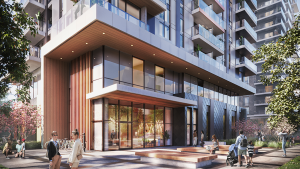Imagine the pressure. You have to design the first post and cable barrier system in Alberta—the first significant installation in Canada—while the media howls for blood because of the blood being spilled on Calgary’s Deerfoot Trail.
Engineering
Biggest engineering challenge was where in the median to put it
Imagine the pressure. You have to design the first post and cable barrier system in Alberta—the first significant installation in Canada—while the media howls for blood because of the blood being spilled on Calgary’s Deerfoot Trail.
In the past three years, eight people and a baby born prematurely when his mother was injured died after out-of-control vehicles crossed the median into opposite lanes of the Deerfoot Trail between 16th Avenue N.E. and Country Hills Boulevard. While there are barriers dividing north and southbound lanes of traffic along some stretches of the Deerfoot, there is wide open space on the 10 km. section some have dubbed the Deathfoot.
Faced with intense media pressure, Lyle Oberg, then minister of Infrastructure and Transportation, instituted a safety review in the fall of 2005 and promised remedial action by last spring. Two Infrastructure and Transportation ministers later there’s still nothing to stop cars crossing the grassy median.
Just before Christmas, an Airdrie man died when his northbound car veered across the median and slammed head-on into a southbound SUV, severely injuring its driver.
EBA Engineering Consultants Ltd. won the assignment to fix the Deerfoot median in January, 2006. Robyn McGregor, senior transportation engineer and principal consultant, is based in Calgary so has to be aware of the vociferous demands for action on the median before someone else dies but she remains cool as a cucumber despite the clamor.
EBA was assigned to work with the Alberta government’s Transportation department on the preliminary engineering, design, tendering and administering of the contract, she says. EBA’s responsibility was “to do the technical aspects of the work in the time required” and she proceeded “with my work as required”.
That work involved researching post-and-cable barrier, a system popular in Texas that received recommendation in the Transportation department’s safety review. EBA studied two Texas companies, Gibraltar and Trinity, and Brifen Canada, headquartered in White Rock, B.C. and consulted with American departments of transport before sending the project to tender last fall.
The Deerfoot will be the first stretch of road in Alberta to use the post-and-cable barrier and, at 10 km., will be the longest, by far, in Canada. Abbottsford and Harrison Hot Springs, B.C. were the first two jurisdictions in Canada to install Brifen Cable Barrier, one of the three companies EBA looked at that produce product to test level four specifications, but those installations are only 35 and 200 metres long.
As McGregor points out, “time is of the essence in any engineering job” and just because everyone from Calgary city councillors to relatives of the dead motorists are screaming for a speedy fix doesn’t mean engineers can or should hurry the process. “It doesn’t impact me at all,” she says, referring timing questions to the Alberta government.
Trent Bancarz, Albert Infrastructure spokesperson, is well aware of the demands for haste. But the system is new and the design work took longer than originally expected. “We wanted to make sure we got it right.” Placement of posts, where to put the barrier in the median to avoid underground utilities and how close to put the cable barrier to existing items were some of the things to be considered in designing the barrier.
The design also had to take into consideration any slope where it was to be installed—a Washington court case arose over cable barriers on a slope that limited their effectiveness—and the placement of cables to catch both large and small vehicles.
The government chose the $1.4 million post and cable barrier system for the Deerfoot because it has been successful in other jurisdictions, he says. “They are quite a bit safer than other barriers for a number of reasons. A concrete barrier, if you hit it the right way, can almost act as a ramp, catapulting bigger transports into the air. We are quite convinced this is the safest option.”
Cheaper than a steel guardrail or concrete barrier, the post-and-cable barrier is designed to catch a vehicle, rather like a spider web that will wrap around the wheels of bigger vehicles and the body of smaller ones, preventing them from ricocheting into other traffic, says Bancarz. As a vehicle hits the barrier the cables give like rubber bands while the socketed posts, freestanding within concrete foundations, collapse.
“The largest engineering challenge was where in the median to put the barrier and its correct height given the slope,” says Bancarz. “Too low and larger vehicles can run over it. It has to be high enough to catch their wheels.”
Whatever’s to blame for the length of time the barrier has taken, it’s not the fault of Volker Stevin Contracting Ltd.. “We’ve been pushing to get the job going” since winning the contract last November 29th, says Peter Markovich, project manager. “We were planning to start work on December 11.” But late paperwork intervened and work didn’t begin until January.
Volker Stevin’s haste has to do with incentives in the tender. While it has until mid-May to complete the contract, the company hopes to have the work complete by April 1 after which the incentives could cost them $1,500 a day. “Any delay is going to be tough on us.”
Weather could be one problem. A mild start to January gave Markovich hope that the temperature would stay around freezing to allow concrete pouring for the foundations without running heat. The job also entails installation of modified thrie beam guard rail and that work can be done whatever the temperature.
Volker Steven chose Gibraltar, headquartered in Burnet, Texas, as supplier. It was the low bidder but Markovich also considered its four-sided post cleaner than the H-iron of competing companies.
Given the carnage on the “Deathfoot”, Markovich worries about his 14-person crew. Had the company started work December 11 employees would have been right in the line of fire of the December accident. Given the 30-metre width of the median, no one understands why out of control motorists can’t stop before they encounter oncoming traffic but Markovich fears trouble.
“We’re told the Deerfoot has the most volume of traffic of any road in Canada. There are 10 accidents a night,” he says. An accident grinds traffic to a halt so fast that the tender calls for Volker Stevin to stop work and remove all signage at the first sign of gridlock.
“We know this project is high profile,” says Markovich. “We’re hoping people will co-operate with us because it’s to everybody’s benefit to get the project done.”
If the first test of post-and-cable-barrier works well, Infrastructure’s Bancarz expects it will be used on other Alberta roads.










Recent Comments
comments for this post are closed